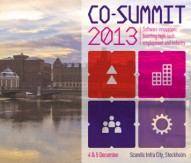
Systems of the future
The ARTEMIS European Technology Platform (ETP) was established in 2004 and designed to bring together key players in the embedded computing arena across the entire spectrum of industrial sectors by five major companies. One of its core tasks was to define a common strategic research agenda, which acts as a reference for the embedded computing domain to attract investment from the stakeholders. The first version of the SRA was published in March 2006, covering the entire needs and challenges of this technology domain.
The ARTEMIS Joint Undertaking (JU) was established in February 2008 as a community body based in Brussels by means of a council regulation. The ARTEMIS JU will implement significant parts of the SRA co-funded by industry, research organisations, participating member states and the Commission’s own ICT programme. The ARTEMIS JU will manage and co-ordinate research activities through open calls for proposals.
ARTEMIS is focused on the research and development of embedded systems and, moving forward, of cyber-physical systems, therefore improving Europe’s competitiveness.
Professor Heinrich Daembkes, president of the ARTEMIS Industry Association Steering Board, ARTEMIS secretary general, Dr Jan Lohstroh, and Mr Ad ten Berg, the ARTEMIS office director, outlined the role that embedded systems will have to play in Europe’s future.
“Embedded systems,” explained Daembkes, “can be described as the combination of hardware and software inside a system, and ARTEMIS is primarily concerned with the software elements. Embedded systems exist in many applications, from a digital watch to a smartphone to the control system of a heating system, the cockpit of an aircraft, cars and medical systems. Thus, without embedded systems, no modern car would function, no plane would fly, and no factory would work, as embedded systems are integral to porcess automation.
“From the realm of mobile communication, a new combination of traditional systems with those concerned with communication is now emerging, which is known as cyber physical systems. This would not be possible without the inclusion of embedded systems, and this area will thus form a future focus for both ARTEMIS and the wider embedded systems community.”
Strength
The field of both embedded and cyber physical systems are thus integral to Europe’s future. ARTEMIS has been working for some time to ensure that Europe remains in a relative position of strength in order to continue developing future generations of embedded and cyber physical systems by establishing a community of players and actors in the field of embedded systems.
“That was Phase One,” Daembkes said. “This was fundamental, as it was of the utmost importance to begin to create some form of synergy to what was, at that stage, an extremely non-harmonised world. Now that this has been achieved, we have begun to work on focusing our industrial and research activities towards those areas in which we feel Europe has a significant strength advantage versus its competitors.”
Jan Lohstroh added: “Indeed, from our research agenda we discovered that there were not enough funding programmes in Europe, and that more activity was needed to keep Europe at a competitive level. We therefore approached the European Commission with that idea, and the ARTEMIS Joint Undertaking emerged.”
“Thus,” he continued, “related to the ARTEMIS brandname, there are two legal entities – the ARTEMIS Industry Association (ARTEMIS-IA) that emerged from the ARTEMIS ETP, and the Artemis JU, whereby we formed a public private partnership, in which ARTEMIS-IA acts as the private partner and working with the Commission and member states to define the programmes which are funded.
“The ARTEMIS-IA contains three groupings: they cover the entire food chain, right from the research activities taking place in universities and research and technology organisations – which are members of our industrial associations, and are delivering the fundamentals, the new elements, and the creativity.”
“Then,” explained Daembkes, “we have a chamber for the SMEs, because, particularly in our market segment and technology domain, it is expected that these enterprises are faster at delivering results. However in reality, only a certain fraction of the SMEs are able to do that, the rest are fully loaded with the demands of daily business.
“The third element is the association of large industry, which has the money, the strategy and the breath to conduct research over a number of years and to bring new systems into the marketplace.”
Joint undertaking
Daembkes was asked whether he felt that changes were needed in the shape and arrangements of these structures. He answered: “Joint undertakings were borne out of the experience gained from the Eureka programmes. Here, there was an issue with how funding was hindered across borders and with the input of individual member states.
“Due to the difficulties to harmonise the efforts between the member states, the Eureka programmes sometimes saw some partners nearing the completion of their projects, while others could not begin because funding had not been released. The intention was thus to create an enhanced synergy, whereby the EU could contribute and act in a harmonising manner. These issues were, indeed, the fundamental ideas behind forming the ARTEMIS joint undertaking.”
Ad ten Berg added: “In a next step, the new idea from the Commission is to bring the three existing ETPs for Nanoelectronics (ENIAC), Embedded Sytems (ARTEMIS), and Smart Systems (EPoSS) together in one new organisation. The first new call will start 2014, meaning that there will be the three initiatives in one joint undertaking.
“We are in constant contact with the Commission and member states about this new structure, and are working very hard to help in the formulation of this new organisation. There are changes in the air, but the concept has been proven in the first phase.”
Daembkes expanded: “The next phase will involve a stronger alignment between the existing joint undertakings. A large part of the constituency of each of these entities is identical, therefore there is a good chance to obtain the required synergy by this close co-operation.”
“For instance, embedded systems rely on advanced microelectronics and nanoelectronics. Without them no embedded system is possible. And vice versa, nanoelectronics are significantly driven in their use and applications by embedded systems.”
One of the main roles of ARTEMIS involves preparing the necessary technology to enable future applications. This technology will come to be increasingly used in areas as diverse as the Internet of Things – an entity using technology based on embedded systems – as well as in the energy sector, where embedded systems are integral to smart distribution and smart grids, and in the newly emerging E-cars and so on, which will all use and be based on embedded systems (among other things, of course, such as new drives, new energy conversion and storage principles, for instance) – but the core, the network inside, will include embedded systems.
“Therefore,” Daembkes highlighted, “we must have multiple avenues to explore in order to prepare for the future.”




